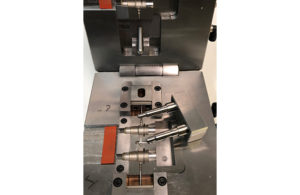How book molds have reinvented vertical injection-molding technology

The medical sector has embraced the high standards that plastic injection molding can offer. Insert molding, especially on a vertical molding press, can hold tight tolerances while also offering design flexibility. These machines provide quicker cycle runs and the option of running up to 12 different molds on one machine at the same time.
Many of today’s new and innovative healthcare devices are made from a combination of thermoplastic resin and specialty medical components, such as cannulae, tubing, wires, cables, stampings and delicate sensors. Advancements in molding technology offer the ability to mold delicate components directly into the devices, rather than incorporating them later through machining, gluing, or ultrasonic welding.
Reinventing the technology
While this technology might not be brand new in and of itself, the process has been reinvented with the use of book molds. Most vertical molding equipment on the market is configured with the top half of the mold attached to the upper platen of the molding machine. The top then closes down with force onto the bottom plate.
It is often difficult to hold delicate inserts in place during the injection molding process, even more so with horizontal molding machines. The possibility for delicate inserts to be interrupted or misplaced is often greater than what manufacturing managers would like to admit. The inserts loaded in the bottom half must be held securely in place so that, when the top closes, neither the mold nor the delicate insert is damaged.
Damage to the mold can be substantial, especially when the two halves close under high tonnage around steel or other rigid materials, so it is important to locate and carefully secure components in place during molding. Still, factors such as operator misplacement or shuttle/rotary table vibration can mean damage to the mold or the inserts.
Book molds can help
A solution that has helped eliminate these complications is using book molds mounted on a rotary table press. Book molds have become prevalent in the production of medical devices, specifically for medical injection molding. They differ from traditional molds as they are typically hinged to each other and open/close like a book (hence the name). These molds can be used on traditional vertical presses, but are commonly found on vertical molding machines with rotary tables.
How they work
Book molds are mounted to vertical clamp/vertical injection molding machines that have multi-station rotary tables. The molds consist of top and bottom mold halves that are connected by a hinge in the back so the top half can be lifted open. The hinge is the lynchpin of the mold and ensures each opening and closing is exactly the same no matter what type of machine it is on.
Like conventional molds, book molds may have taper locks to maintain alignment between both halves to avoid shifting. A tapered sprue bushing is located on the top of the mold so that, when the mold is opened, the sprue and runner will remain in the bottom half.
Ejectors are installed in the bottom half to lift out finished parts along with the sprue and runner, so multiple cavities are often well-suited for book molds. A handle is often mounted on the top half for easy opening, which can be done manually by the press operator or with a stationary ramp.
Another benefit
One service that is best used with book molds is overmolding. Overmolding is often confused with insert molding because it is performed on the same injection-molding machines. Overmolding is a subset of insert molding. All overmolding is insert molding, but it does not go both ways.
The term “insert molding” is often used when a pre-produced part is inserted into a mold and receives a mold around it. Overmolding is a similar process but is typically used when a part needs a second operation over the initial insert molding. It is still an insert-molded product, but the process is referred to as overmolding. Overmolding is also commonly referred to as “injection molding with a second operation,” or “insert molding with an overmolded sequence.”
The manufacturing process should always be in the forefront of a medical device engineer’s mind as manufacturing costs quickly rise with the complexity of each part. The best way to keep manufacturing efforts efficient and affordable, is to find a capable vertical molding manufacturer to help through the entire process.
from:medical design and outsourcing










